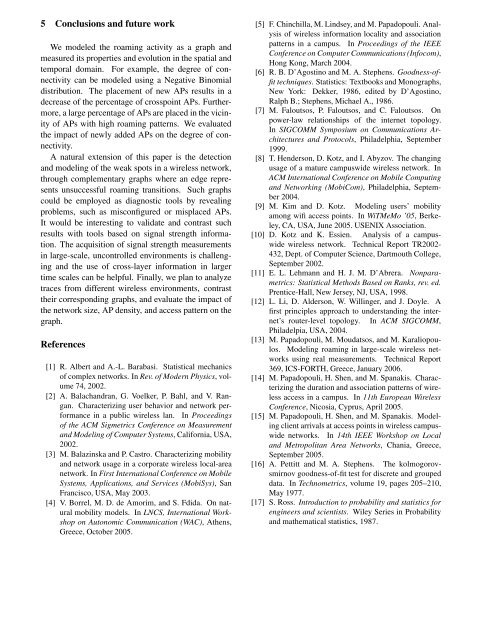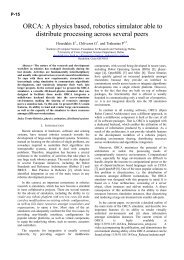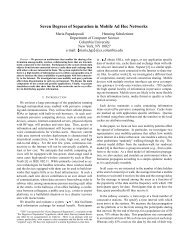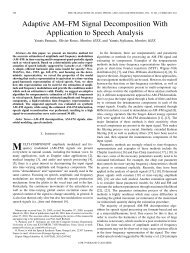Modeling Roaming in Large-scale Wireless Networks using Real ...
Modeling Roaming in Large-scale Wireless Networks using Real ...
Modeling Roaming in Large-scale Wireless Networks using Real ...
You also want an ePaper? Increase the reach of your titles
YUMPU automatically turns print PDFs into web optimized ePapers that Google loves.
5 Conclusions and future work<br />
We modeled the roam<strong>in</strong>g activity as a graph and<br />
measured its properties and evolution <strong>in</strong> the spatial and<br />
temporal doma<strong>in</strong>. For example, the degree of connectivity<br />
can be modeled us<strong>in</strong>g a Negative B<strong>in</strong>omial<br />
distribution. The placement of new APs results <strong>in</strong> a<br />
decrease of the percentage of crosspo<strong>in</strong>t APs. Furthermore,<br />
a large percentage of APs are placed <strong>in</strong> the vic<strong>in</strong>ity<br />
of APs with high roam<strong>in</strong>g patterns. We evaluated<br />
the impact of newly added APs on the degree of connectivity.<br />
A natural extension of this paper is the detection<br />
and model<strong>in</strong>g of the weak spots <strong>in</strong> a wireless network,<br />
through complementary graphs where an edge represents<br />
unsuccessful roam<strong>in</strong>g transitions. Such graphs<br />
could be employed as diagnostic tools by reveal<strong>in</strong>g<br />
problems, such as misconfigured or misplaced APs.<br />
It would be <strong>in</strong>terest<strong>in</strong>g to validate and contrast such<br />
results with tools based on signal strength <strong>in</strong>formation.<br />
The acquisition of signal strength measurements<br />
<strong>in</strong> large-<strong>scale</strong>, uncontrolled environments is challeng<strong>in</strong>g<br />
and the use of cross-layer <strong>in</strong>formation <strong>in</strong> larger<br />
time <strong>scale</strong>s can be helpful. F<strong>in</strong>ally, we plan to analyze<br />
traces from different wireless environments, contrast<br />
their correspond<strong>in</strong>g graphs, and evaluate the impact of<br />
the network size, AP density, and access pattern on the<br />
graph.<br />
References<br />
[1] R. Albert and A.-L. Barabasi. Statistical mechanics<br />
of complex networks. In Rev. of Modern Physics,volume<br />
74, 2002.<br />
[2] A. Balachandran, G. Voelker, P. Bahl, and V. Rangan.<br />
Characteriz<strong>in</strong>g user behavior and network performance<br />
<strong>in</strong> a public wireless lan. In Proceed<strong>in</strong>gs<br />
of the ACM Sigmetrics Conference on Measurement<br />
and <strong>Model<strong>in</strong>g</strong> of Computer Systems, California, USA,<br />
2002.<br />
[3] M. Balaz<strong>in</strong>ska and P. Castro. Characteriz<strong>in</strong>g mobility<br />
and network usage <strong>in</strong> a corporate wireless local-area<br />
network. In First International Conference on Mobile<br />
Systems, Applications, and Services (MobiSys), San<br />
Francisco, USA, May 2003.<br />
[4] V. Borrel, M. D. de Amorim, and S. Fdida. On natural<br />
mobility models. In LNCS, International Workshop<br />
on Autonomic Communication (WAC), Athens,<br />
Greece, October 2005.<br />
[5] F. Ch<strong>in</strong>chilla, M. L<strong>in</strong>dsey, and M. Papadopouli. Analysis<br />
of wireless <strong>in</strong>formation locality and association<br />
patterns <strong>in</strong> a campus. In Proceed<strong>in</strong>gs of the IEEE<br />
Conference on Computer Communications (Infocom),<br />
Hong Kong, March 2004.<br />
[6] R. B. D’Agost<strong>in</strong>o and M. A. Stephens. Goodness-offit<br />
techniques. Statistics: Textbooks and Monographs,<br />
New York: Dekker, 1986, edited by D’Agost<strong>in</strong>o,<br />
Ralph B.; Stephens, Michael A., 1986.<br />
[7] M. Faloutsos, P. Faloutsos, and C. Faloutsos. On<br />
power-law relationships of the <strong>in</strong>ternet topology.<br />
In SIGCOMM Symposium on Communications Architectures<br />
and Protocols, Philadelphia, September<br />
1999.<br />
[8] T. Henderson, D. Kotz, and I. Abyzov. The chang<strong>in</strong>g<br />
usage of a mature campuswide wireless network. In<br />
ACM International Conference on Mobile Comput<strong>in</strong>g<br />
and Network<strong>in</strong>g (MobiCom), Philadelphia, September<br />
2004.<br />
[9] M. Kim and D. Kotz. <strong>Model<strong>in</strong>g</strong> users’ mobility<br />
among wifi access po<strong>in</strong>ts. In WiTMeMo ’05, Berkeley,<br />
CA, USA, June 2005. USENIX Association.<br />
[10] D. Kotz and K. Essien. Analysis of a campuswide<br />
wireless network. Technical Report TR2002-<br />
432, Dept. of Computer Science, Dartmouth College,<br />
September 2002.<br />
[11] E. L. Lehmann and H. J. M. D’Abrera. Nonparametrics:<br />
Statistical Methods Based on Ranks, rev. ed.<br />
Prentice-Hall, New Jersey, NJ, USA, 1998.<br />
[12] L. Li, D. Alderson, W. Will<strong>in</strong>ger, and J. Doyle. A<br />
first pr<strong>in</strong>ciples approach to understand<strong>in</strong>g the <strong>in</strong>ternet’s<br />
router-level topology. In ACM SIGCOMM,<br />
Philadelpia, USA, 2004.<br />
[13] M. Papadopouli, M. Moudatsos, and M. Karaliopoulos.<br />
<strong>Model<strong>in</strong>g</strong> roam<strong>in</strong>g <strong>in</strong> large-<strong>scale</strong> wireless networks<br />
us<strong>in</strong>g real measurements. Technical Report<br />
369, ICS-FORTH, Greece, January 2006.<br />
[14] M. Papadopouli, H. Shen, and M. Spanakis. Characteriz<strong>in</strong>g<br />
the duration and association patterns of wireless<br />
access <strong>in</strong> a campus. In 11th European <strong>Wireless</strong><br />
Conference, Nicosia, Cyprus, April 2005.<br />
[15] M. Papadopouli, H. Shen, and M. Spanakis. <strong>Model<strong>in</strong>g</strong><br />
client arrivals at access po<strong>in</strong>ts <strong>in</strong> wireless campuswide<br />
networks. In 14th IEEE Workshop on Local<br />
and Metropolitan Area <strong>Networks</strong>, Chania, Greece,<br />
September 2005.<br />
[16] A. Pettitt and M. A. Stephens. The kolmogorovsmirnov<br />
goodness-of-fit test for discrete and grouped<br />
data. In Technometrics, volume 19, pages 205–210,<br />
May 1977.<br />
[17] S. Ross. Introduction to probability and statistics for<br />
eng<strong>in</strong>eers and scientists. Wiley Series <strong>in</strong> Probability<br />
and mathematical statistics, 1987.
















